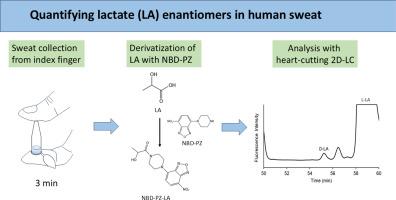用二维液相色谱法定量测定人体汗液样品中的乳酸对映体
IF 3.2
引用次数: 0
摘要
乳酸(LA)主要由人体内丙酮酸的还原产生,对于通过厌氧糖酵解产生能量至关重要。虽然D-LA浓度明显低于L-LA,但在一些疾病中,有报道称D-LA浓度单独显著升高。定量测定人体液中的LA对映体具有疾病诊断的潜力。汗液最近被认为是血液的一种新的生物替代品,因为它可以无创取样。因此,本研究建立了采用高灵敏度荧光检测方法的切心二维液相色谱法(2D-LC),用于少量人体汗液中LA对映体的分析。LA与4-硝基-7-哌嗪基-2,1,3-苯并恶二唑(NBD-PZ)进行衍生化反应,并用十八烷基硅柱在一维上分离内源性化合物。随后,在手性柱上对NBD-PZ-LA峰进行二次分馏和对映体分离。充分的线性(R²>;NBD-PZ-D-LA和NBD-PZ-L-LA在1-100µM和10-1000µM范围内的浓度分别为0.999)。相应的定量限分别为0.97和1.12µM。精密度为1.04% ~ 12.03%,准确度为85.6% ~ 100.4%。所开发的方法成功地应用于5名健康受试者的人体汗液中。汗液中D-LA和L-LA的浓度分别为30.29±20.18µM和23.69±12.15 mM。所开发的2D-LC系统可作为无创生物标志物应用于人体汗液中的LA对映体分析。本文章由计算机程序翻译,如有差异,请以英文原文为准。

Quantification of lactate enantiomers in human sweat samples using two-dimensional liquid chromatography
Lactate (LA) is primarily produced by the reduction of pyruvate in the human body and is crucial for energy production via anaerobic glycolysis. Although the D-LA concentration is considerably lower than that of L-LA, a significant increase in D-LA concentration alone has been reported in some diseases. Quantifying LA enantiomers in human biofluids has the potential for disease diagnosis. Sweat has recently been recognized as a novel biological alternative to blood because it can be sampled non-invasively. Therefore, in this study, heart-cutting two-dimensional liquid chromatography (2D-LC) using a highly sensitive fluorescence detection method was developed for the analysis of LA enantiomers in small amounts of human sweat. LA was derivatized with 4-nitro-7-piperazino-2,1,3-benzoxadiazole (NBD-PZ) and separated from endogenous compounds using an octadecyl silica column in the first dimension. Subsequently, the NBD-PZ-LA peak was fractionated and enantiomerically separated in the second dimension on a chiral column. Sufficient linearities (R² > 0.999) were observed in the ranges of 1–100 and 10–1000 µM for NBD-PZ-D-LA and NBD-PZ-L-LA, respectively. The corresponding limits of quantification were 0.97 and 1.12 µM. The precision values were 1.04 %–12.03 %, and the accuracies were 85.6 %–100.4 %. The developed method was successfully applied to ∼5 µL of human sweat collected from five healthy subjects. The concentrations of D-LA and L-LA in sweat were 30.29 ± 20.18 µM and 23.69 ± 12.15 mM, respectively. The developed 2D-LC system should be clinically applicable to LA enantiomer analysis in human sweat as a non-invasive biomarker.
求助全文
通过发布文献求助,成功后即可免费获取论文全文。
去求助
来源期刊

Journal of chromatography open
Analytical Chemistry
CiteScore
2.50
自引率
0.00%
发文量
0
审稿时长
50 days
 求助内容:
求助内容: 应助结果提醒方式:
应助结果提醒方式:


